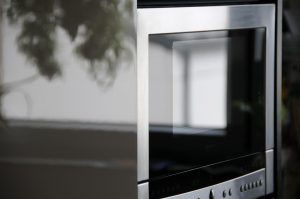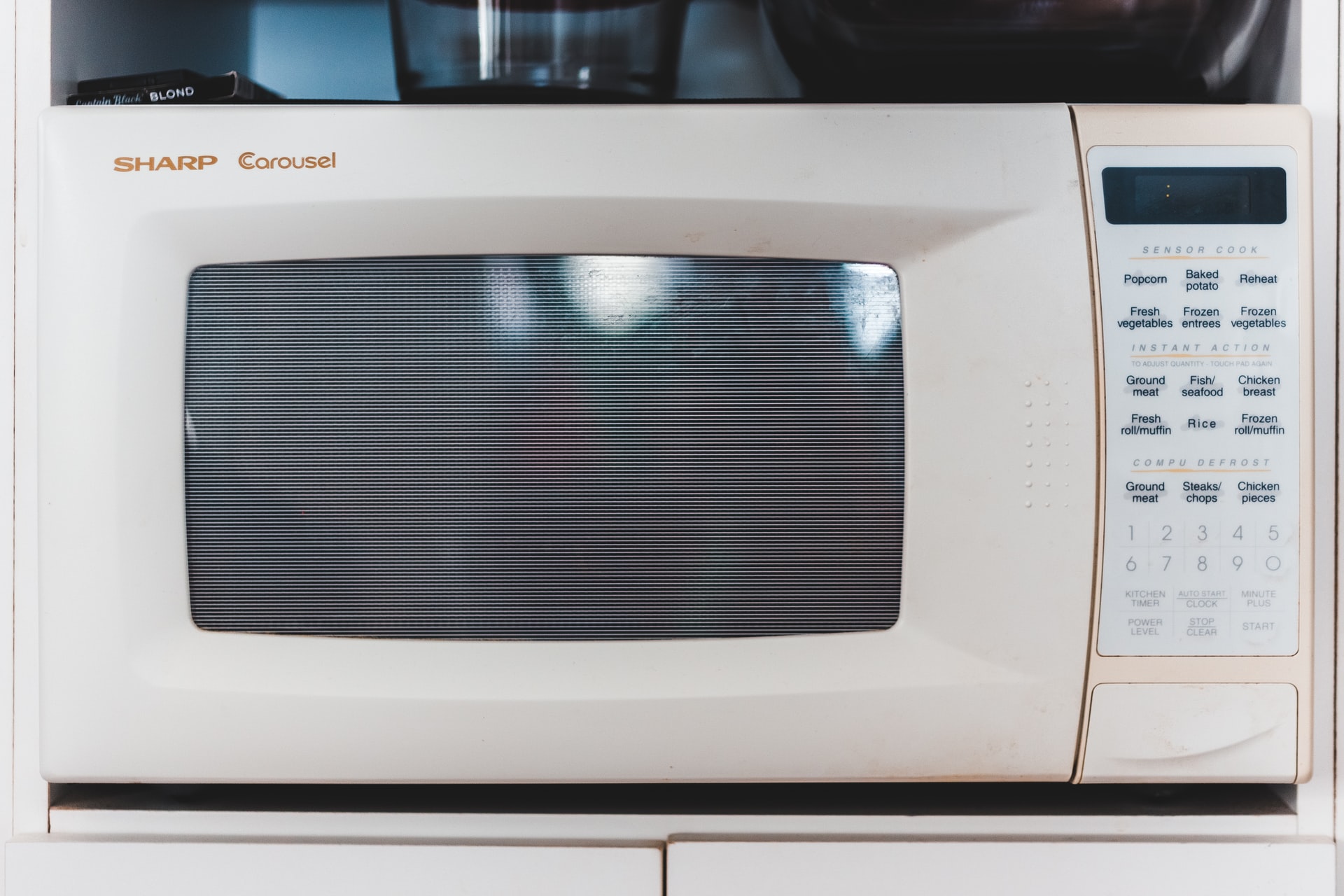If you’ve noticed rust inside your microwave it can be quite disturbing as it’s hard to know whether you can still use it or not – but is it bad if your microwave has rust inside or is this a myth?
It is definitely bad if your microwave has rust inside, as this means that the interior walls of the microwave are damaged. Using a microwave in this condition can lead to sparking, as well as radiation leakage – it is also likely that your food will become contaminated as well.
In the rest of this article, we will explore exactly what causes rust inside microwaves in the first place, as well as share some top tips for removing and preventing rust.
Let’s get straight into it!
What Causes Rust In Microwaves?
Rust inside microwaves is caused by damage to the interior walls of the microwave.
As the walls get damaged the paint can peel off, exposing the metal surface beneath to the elements where it may react with oxygen in the air forming rust. This damage can be the result of a few different things:
- Food sticking to the walls – If food becomes stuck on the wall it will create a hotspot that will heat up during use. Over time this will damage the wall and remove the paint, exposing the surface below to oxygen.
- Scratches – If you use sharp utensils around your microwave you may accidentally scratch one of the walls which creates areas for rust to occur.
What Speeds Up The Rusting Process?
Damaged microwave walls will rust over time, but this can be sped up by the presence of moisture.
In exactly the same way that a bicycle left out in the rain rusts rapidly, if moisture is present within your microwave it will speed up the oxidation process. Unfortunately, microwaves are prone to moisture due to the way in which they work.
Preventing moisture is one of the key methods to reduce rusting in a microwave, and we will share some methods for this later in the article.
Why Is Rust Bad In Microwaves?
Rust is bad for a lot of reasons, and it’s important to understand these reasons for your own safety and health.
Arcing (Sparking)
You probably know that when a metallic object is placed into a microwave it causes sparks.
Withing diving into the technicalities of it, microwaves produced by the magnetron in the oven interact with metallic objects in such a way that sparks and excess heat energy are produced. This is a major fire hazard that should be avoided at all costs, as reiterated by the FDA.
Rust acts in a similar way and can cause this phenomenon itself, which is one of the main reasons why rust is very bad inside a microwave.
Microwave Exposure
Because of the way rust is formed, its presence indicates that the inner walls of your microwave are damaged.
The inner walls are designed to keep microwave radiation within the oven, which means that there is a possibility for microwave radiation leakage if the walls are heavily rusted.
Large microwave radiation exposure has been linked to injuries in some very rare cases, so this is something to consider as well if you notice rust within your microwave.
Food Contamination
Another reason why rust is so bad in microwaves is much more obvious – it can contaminate food easily. Hygiene should be of utmost importance when preparing food, and since rust is classified as not food-safe it is not advisable to make your food near it.
You wouldn’t prepare food in a rusty environment, so why should a microwave oven be any different?
It’s also important to think about the bacteria that might be present in the rust as well – there is a reason why an unclean microwave is one of the main reasons for rust forming in the first place.
How To Prevent Rust In Microwaves
So, now that we understand why rust is bad in microwaves and what causes it, let’s take a look at some methods for preventing rust in the first place.
Clean Regularly
This one is quite obvious, but it is something that is often overlooked.
A microwave should ideally be cleaned once per week to prevent food buildup. You should also quickly check the walls after heating up food, particularly ready meals, as these can be prone to spitting food and grease at the walls during cooking.
Check The Walls For Damage
If your microwave walls are in good condition then the likelihood of rust forming becomes very, very small.
Due to this, you need to check them often for any signs of scratches or clumps of stuck food. If you can spot the damage early, you can prevent rust from forming by repairing the issue.
Use A Microwave Food Cover
An easy way to reduce the amount of food and moisture ending up on your microwave walls is to use a microwave food cover.
These can be found in pretty much any general store, and are very convenient if you don’t like wiping down your microwave often.
Avoid Moisture
As we mentioned earlier, moisture will accelerate rust growth and so it is important to keep this to a minimum.
Use a dry rag or towel to wipe down the sides of your microwave before you shut it to ensure that moisture is left to a minimum. You don’t need to do this every time you use the oven, but if the food you are cooking is prone to causing condensation then it’s a good idea to implement it.

How To Clean Rust In Microwaves
Preventing rust from forming is great and all, but what should you do if there is already rust in your microwave?
If you already have a significant amount of rust in your microwave it can be removed through cleaning. Once removed you can repair the damage that it has left behind.
Follow the steps below to clean rust quickly:
- Unplug the microwave and remove the turntable support and plate from the oven. Place these in a tub of warm water and dish soap and leave them to soak.
- Rinse the interior with a damp cloth and a few drops of dish soap. Pay attention to removing any grease marks or food and then wipe dry with a rag.
- Mix equal amounts of baking soda and water together to form a paste and apply this to the rust.
- Scrub the rust with a sponge until it is removed and wipe dry.
- Remove the turntable support and plate from the soaking solution and wipe then clean with another dishcloth. Place them back into place once they have been cleaned.
Can Rust-Damaged Microwaves Be Repaired?
Rust-damaged microwaves can be repaired if the rust is surface level, but before you attempt any DIY method you should get in touch with your manufacturer to see whether your warranty is valid and if it covers rust damage.
We generally recommend consulting a professional to repair severe rust damage, or simply replacing the microwave entirely. However, if you want to attempt to repair your microwave by yourself you can use the steps below to do so.
Remove Rust As Before
The first step in repairing a rust-damaged microwave is to remove the rust as before in the cleaning steps.
Remember that surface-level rust is repairable, but if the rust has gone below the surface you will have to replace your oven.
Apply Paint
Once the rust is removed you can apply paint to the walls to re-seal them.
Make sure that the paint is microwave-friendly before you start – this should be indicated on the label. Start by applying a small amount of paint to one of the walls and let it dry fully, this will be used to test the paint to make sure it works.
Once dry, turn the microwave on for a minute and then open the door. If the paint spot has heated up excessively then the paint is not suited for your microwave and you will need to contact a professional for advice.
If the paint doesn’t heat up you can apply paint to the rest of the surface and allow it to dry out fully. This can be repeated a few times for a strong coating.
When To Replace A Rust-Damaged Microwave
If the amount of rust is excessive then it is better to replace the microwave than to try and repair it.
Excessive rust can lead to holes in the wall which aren’t even worth repairing, and it also poses health risks associated with microwave radiation leakage as well as increasing the chance of arcing which is a fire hazard.
Final Thoughts
Rust inside a microwave is definitely a bad sign, but it’s also something that can be repaired if the amount of rust is minimal.
In severe cases, it makes more sense to replace the microwave entirely, but you can use this guide as a way to inform your decision.
